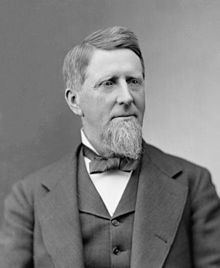Name John Starin | Role U.S. representative | |
 | ||
Died March 21, 1909, New York City, New York, United States | ||
Sea01Epi2 Starin Place and Home
John Henry Starin (August 27, 1825 – March 21, 1909) was a U.S. Representative from New York, grandson of Thomas Sammons. He also founded Starin's Glen Island Resort, America's first amusement park.
Contents
- Sea01Epi2 Starin Place and Home
- Early life and education
- Career
- Starins Glen Island Resort
- The Starin Mausoleum
- Death
- References
Early life and education
Born in Sammonsville, Fulton County (then a part of Montgomery County), New York. Starin pursued academic studies in Esperance, New York, where he began the study of medicine in 1842.
Career
He established and operated a drug and medicine business in Fultonville, New York, from 1845–1858. From 1848–1852, he also served as Postmaster of Fultonville.
Additionally, Starin was the founder and president of the Starin City River & Harbor Transportation Co. and served as director of the North River Bank, in New York City, and the Mohawk River National Bank. He was also interested in agriculture and stock raising.
Starin was elected as a Republican to the Forty-fifth and Forty-sixth Congresses (March 4, 1877 – March 3, 1881). From 1883–1909, he served as president of Fultonville National Bank. He engaged in railroading and served as member of the New York City Rapid Transit Commission, as well.
Starin's Glen Island Resort
In 1878, Starin purchased a series of small islands off the coast of New Rochelle, New York for his country estate and eventually turned the property into an amusement park called Starin's Glen Island. He maintained the islands as a select summer resort, operating 12 steamboats to and from New York City. The islands were so popular that hundreds of thousands of visitors were brought every season to the attractions which included a zoo, a natural history museum, a railway, a German beer garden (around the castle-like structure which still stands today), a bathing beach, and a Chinese pagoda. A chain ferry transported visitors from a mainland dock on Neptune Island.
By 1882, attendance reached half a million and within six years it broke a million. However, despite the large number of visitors, Starin stressed the well-behaved nature of the crowds and the orderly character of the experience, governed by a "middle-class code of conduct". His desire was to offer an environment of order and civility which contrasted to the rough-and-tumble atmosphere of New York City. One of the effects of Glen Island's popularity in the beginning of the twentieth century was the building boom in New Rochelle, which had rapidly grown into a summer resort community.
The Starin Mausoleum
The Starin Mausoleum was constructed in Fultonville Cemetery in the early 1880s. The building was approximately 50 feet tall, 33 feet across, and 24 feet deep. The Starin mausoleum no longer stands in Fultonville Cemetery, but remnants of the foundation can still be found.
When John H. Starin died in 1909, he left the ownership and the care of the mausoleum to the Starin Benevolent & Industrial Association, which ceased to exist in 1917. In the 1970s, the mausoleum began to fall into disrepair. Sometime around this time, it was also vandalized on Halloween by a group of teenagers, who destroyed most of the caskets and bodies.
In the summer of 1975 the mausoleum was taken down, the remains that were left in the mausoleum were re-interred in front of where it once stood, and markers were placed on the graves. At the time of the demolition there was very little left to the mausoleum. Today, a modest upright granite slab with a bronze face marks Starin's grave and those of his family members.
Death
Starin died in New York City on March 21, 1909 and was interred in The Starin Mausoleum, in Fultonville Cemetery, Fultonville.
